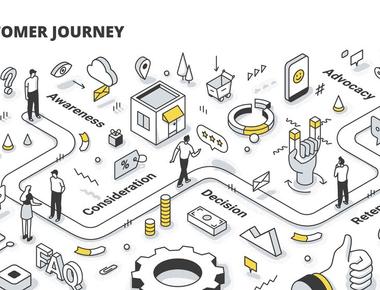A customer journey map is a graphical representation of a customer’s total interaction and experience with an organisation or product, across both minor and major sales channels. This journey starts from when the customer becomes aware of a particular need for a service or product, through efforts on finding a solution, choosing from various options, until he/she makes a purchase. A customer journey map may not always consist of the entire start to finish sequence description we just saw; sometimes, only few elements of a customer’s experience are enough to define that particular customer’s journey map.
Whenever a customer initiates an interaction with an organisation, such interactions arise because of questions to which the customer needs answers. The effort to provide answers to such questions creates conversations between the customers and the organisation. For instance, such a conversation may consist of the organisation asking the type of questions that will help it understand customers’ needs, what they want from the organisation, and their expectations. These questions will help the customers guide the organisation on ways of fulfilling these needs.
Customers appreciate these types of conversations because they feel they have some value to create for the organisation. The customers’ needs, expectations, requirements, and suggestions become great benefits to the company, because they all combine to form the basis for the organisation to improve and create better products and services.
A customer journey map seeks to create an insight into everything a customer desires from an organisation, and helps the organisation understand the ways a customer uses its products or services. This synergy helps develop the customer’s confidence over time, with a greater possibility of well-informed feedback, which helps the organisation become a better brand, offer better and unique products and services that addresses customer needs.
Customer journey maps help reveal factors that create bad customer experiences such as: Inefficiency in devices: Customers are always searching for easy-to-use devices and services that will give them the desired satisfactory experience. However, when customers encounter devices and applications that are difficult to manipulate, they tend to get frustrated easily and look for easier-to-use alternative devices and applications of other companies.
Inefficiency in the departments: When a particular department within the organisation does not have a clearly defined role and responsibility, customers will find it hard getting the best experience and realising their expectations from that department. This will cause a shift of attention away from either that department, or from the organisation entirely.
Inefficiency in deliver channels: Modern technology has created a diverse environment, which enables organisations to present their products and services through a wide range of sales and delivery channels. The social media is one significant platform customers love to use in investigating their choices before making a buying decision. An organization without a social media presence has created gaps between its delivery channels. When there is a lack of social media presence, customers will have no way of having an online interactive experience with the organisation and will definitely look elsewhere to find that experience.
The customer journey map has revealed that the customer is, and should be the focal point of any organisation’s activities. Researches, developments, innovations, strategies, planning etc., must all revolve around the customers, their needs, and ways of meeting those needs. The map also lays emphasis on the importance and popularity of the social media with respect to customer experience. The customer journey map investigates the level of use of social media as an interactive channel by customers, in the effort to determine if an organisation’s products and services can meet their needs. This map helps organisations discover their strengths and weaknesses, improve their focus, and discover and adapt to the ever-changing world of technology
Customer journey map encourages the organisation’s staff to focus their attention towards understanding customers’ needs and expectations, and interpreting their experiences and feedbacks. The use of social media is an effective result-oriented strategy, which can assist an organisation towards this interpretation. Incorporating staff in a customer journey map shows that the organisation values the customer greatly and will use all of its resources, both human and material to ensure that customers get the experience they desire. Similarly, staff will have a greater sense of responsibility and job satisfaction because the organisation found them worthy strategic partners.
A customer journey map should not be difficult to understand. The map must be easy to read, understand, and interpret. It must be flexible enough to assume any format or shape as long as the chosen format encourages interaction with customers, through making them know and understand the company’s operation, products, and services. The map should be highly visible, with all the customers’ needs and expectations clearly stated, and highlighted on it. All information must be clear enough to avoid misinterpretation. A customer journey map should be on a wall where it will have maximum exposure to all.
The important elements that should be in any customer journey map include: Customer perspective representation: This element makes use of social media structure to foster closer ties between the customer and the organisation in order to work towards actualising the customer’s expectations.
Research utilisation:
Instead of using your own staff to conduct research into customer behaviour, the result will be more impactful if you use the real customers in this regard. Any feedback you get at this stage will be targeted information. Research and surveys that involve the actual customers will assist an organisation assess the demand for its products and services, and design a more realistic and better-informed customer journey map.
Friendliness:
Do not design a customer journey map that is too serious and business-like. Make use of fonts, styles, bright and warm colours that signify energy and fun to liven the map.
Customer goals:
What are the goals of your customers? You should find out what they are and use them as the basis for the design of the customer journey map. Although over time, these goals may change, you have to make sure that at any point in time, your customer journey map reflects the current goals of your customers.
Strengths:
Use your social media platform to promote the strengths and positive qualities of the organisation. Make the total experience of the customer through the social media positive. Avoid highlighting any weakness or controversial stories that will make the customer lose confidence in the organisation’s brand image. You should remove all products and services that are no longer available from your social platforms because they create the wrong customer experience when customers inquire of them and learn they are not available.
Timeline/History:
Naturally, customers will trust an older organisation with established reputation, over a newer company without any historical achievement. Therefore, endeavour to include and highlight the age of the organisation and the length of time it has been offering its products and service. This information will lend more credence to the customer journey map.
Brand deliverables:
Your organisation’s mission and vision form the basis for the formulation of your organisation’s strategies and business functions. They also help educate the customers about your values, ethics, aspirations, offerings, and corporate practices. Therefore, you should ensure that your mission and vision get maximum exposure on the organisation’s profile and social media platform. This will equip customers with the right information to take the right buying decisions.
Examples and Adaptations of the Customer Journey Map
Let us see how some companies created and adapted the customer journey map to their businesses.
IKEA -
 IKEA designed a customer journey map in the form of a graph that consists of different levels of peaks. These peaks represent the customer’s experience. The highest peak indicates excellent experience while the lowest peak suggests bad experience. The graph and its features are clear, easy to understand, and fulfils the quality of a good customer journey map.
IKEA designed a customer journey map in the form of a graph that consists of different levels of peaks. These peaks represent the customer’s experience. The highest peak indicates excellent experience while the lowest peak suggests bad experience. The graph and its features are clear, easy to understand, and fulfils the quality of a good customer journey map.
LEGO
 LEGO created a unique customer journey map, which it gave the name “Experience Wheel.” LEGO’s Experience wheel makes use of an illustration of a hypothetic flight to New York City to explain customer experience. At the core of the wheel is an inner circle that describes the customer. As we move outwards, we notice the wheel becoming bigger with several customer experiences. These experiences occupy three segments that explain the customer’s experience before, during, and after the flight. The designers of this map made use of several emoticons to represent these experiences. A smiley stands for good experience while the red angry emoticon represents a negative experience. The map targets new customers and those that transact at the front office, and makes available to them all information that pertains to the organization’s products and services.
LEGO created a unique customer journey map, which it gave the name “Experience Wheel.” LEGO’s Experience wheel makes use of an illustration of a hypothetic flight to New York City to explain customer experience. At the core of the wheel is an inner circle that describes the customer. As we move outwards, we notice the wheel becoming bigger with several customer experiences. These experiences occupy three segments that explain the customer’s experience before, during, and after the flight. The designers of this map made use of several emoticons to represent these experiences. A smiley stands for good experience while the red angry emoticon represents a negative experience. The map targets new customers and those that transact at the front office, and makes available to them all information that pertains to the organization’s products and services.
There is no strict ‘way’ to create a customer journey map, as long as you managed to find out what you set out to discover, you pretty much got it right.



